Choosing a Gaming CPU: Single + Multi-GPU at 1440p, April 2013
by Ian Cutress on May 8, 2013 10:00 AM ESTCPUs, GPUs, Motherboards, and Memory
For an article like this, getting a range of CPUs, which includes the most common and popular, is very important. I have been at AnandTech for just over two years now, and in that time we have had Sandy Bridge, Llano, Bulldozer, Sandy Bridge-E, Ivy Bridge, Trinity and Vishera, of which I tend to get supplied the top end processors of each generation for testing. (As a motherboard reviewer, it is important to make the motherboard the limiting factor.) A lot of users have jumped to one of these platforms, although a large number are still on Wolfdale (Core2), Nehalem, Westmere, Phenom II (Thuban/Zosma/Deneb) or Athlon II.
I have attempted to pool all my AnandTech resources, contacts, and personal resources together to get a good spread of the current ecosystem, with more focus on the modern end of the spectrum. It is worth noting that a multi-GPU user is more likely to have the top line Ivy Bridge, Vishera or Sandy Bridge-E CPU, as well as a top range motherboard, rather than an old Wolfdale. Nevertheless, we will see how they perform. There are a few obvious CPU omissions that I could not obtain for this first review which will hopefully be remedied over time in our next update.
The CPUs
My criteria for obtaining CPUs was to use at least one from the most recent architectures, as well as a range of cores/modules/threads/speeds. The basic list as it stands is:
AMD |
|||||||
| Name |
Platform / Architecture |
Socket |
Cores / Modules (Threads) |
Speed | Turbo | L2/L3 Cache | |
|---|---|---|---|---|---|---|---|
| A6-3650 | Llano | FM1 | 4 (4) | 2600 | N/A | 4 MB / None | |
| A8-3850 | Llano | FM1 | 4 (4) | 2900 | N/A | 4 MB / None | |
| A8-5600K | Trinity | FM2 | 2 (4) | 3600 | 3900 | 4 MB / None | |
| A10-5800K | Trinity | FM2 | 2 (4) | 3800 | 4200 | 4 MB / None | |
| Phenom II X2-555 BE | Callisto K10 | AM3 | 2 (2) | 3200 | N/A | 1 MB / 6 MB | |
| Phenom II X4-960T | Zosma K10 | AM3 | 4 (4) | 3200 | N/A | 2 MB / 6 MB | |
| Phenom II X6-1100T | Thuban K10 | AM3 | 6 (6) | 3300 | 3700 | 3 MB / 6 MB | |
| FX-8150 | Bulldozer | AM3+ | 4 (8) | 3600 | 4200 | 8 MB / 8 MB | |
| FX-8350 | Piledriver | AM3+ | 4 (8) | 4000 | 4200 | 8 MB / 8 MB | |
Intel |
|||||||
| Name | Architecture | Socket |
Cores (Threads) |
Speed | Turbo | L2/L3 Cache | |
| E6400 | Conroe | 775 | 2 (2) | 2133 | N/A | 2 MB / None | |
| E6700 | Conroe | 775 | 2 (2) | 2667 | N/A | 4 MB / None | |
| Celeron G465 | Sandy Bridge | 1155 | 1 (2) | 1900 | N/A | 0.25 MB / 1.5 MB | |
| Core i5-2500K | Sandy Bridge | 1155 | 4 (4) | 3300 | 3700 | 1 MB / 6 MB | |
| Core i7-2600K | Sandy Bridge | 1155 | 4 (8) | 3400 | 3800 | 1 MB / 8 MB | |
| Core i3-3225 | Ivy Bridge | 1155 | 2 (4) | 3300 | N/A | 0.5 MB / 3 MB | |
| Core i7-3770K | Ivy Bridge | 1155 | 4 (8) | 3500 | 3900 | 1 MB / 8 MB | |
| Core i7-3930K | Sandy Bridge-E | 2011 | 6 (12) | 3200 | 3800 | 1.5 MB / 12 MB | |
| Core i7-3960X | Sandy Bridge-E | 2011 | 6 (12) | 3300 | 3900 | 1.5 MB / 15 MB | |
| Xeon X5690 | Westmere | 1366 | 6 (12) | 3467 | 3733 | 1.5 MB / 12 MB | |
A small selection
There omissions are clear to see, such as the i5-3570K, a dual core Llano/Trinity, a dual/tri module Bulldozer/Piledriver, i7-920, i7-3820, or anything Nehalem. These will hopefully be coming up in another review.
The GPUs
My first and foremost thanks go to both ASUS and ECS for supplying me with these GPUs for my test beds. They have been in and out of 60+ motherboards without any issue, and will hopefully continue. My usual scenario for updating GPUs is to flip AMD/NVIDIA every couple of generations – last time it was HD5850 to HD7970, and as such in the future we will move to a 7-series NVIDIA card or a set of Titans (which might outlive a generation or two).
ASUS HD 7970 (HD7970-3GD5)
The ASUS HD 7970 is the reference model at the 7970 launch, using GCN architecture, 2048 SPs at 925 MHz with 3GB of 4.6GHz GDDR5 memory. We have four cards to be used in 1x, 2x, 3x and 4x configurations where possible, also using PCIe 3.0 when enabled by default.
ECS GTX 580 (NGTX580-1536PI-F)
ECS is both a motherboard manufacturer and an NVIDIA card manufacturer, and while most of their VGA models are sold outside of the US, some do make it onto etailers like Newegg. This GTX 580 is also a reference model, with 512 CUDA cores at 772 MHz and 1.5GB of 4GHz GDDR5 memory. We have two cards to be used in 1x and 2x configurations at PCIe 2.0.
The Motherboards
The CPU is not always the main part of the picture for this sort of review – the motherboard is equally important as the motherboard dictates how the CPU and the GPU communicate with each other, and what the lane allocation will be. As mentioned on the previous page, there are 20+ PCIe configurations for Z77 alone when you consider some boards are native, some use a PLX 8747 chip, others use two PLX 8747 chips, and about half of the Z77 motherboards on the market enable four PCIe 2.0 lanes from the chipset for CrossFireX use (at high latency).
We have tried to be fair and take motherboards that may have a small premium but are equipped to deal with the job. As a result, some motherboards may also use MultiCore Turbo, which as we have detailed in the past, gives the top turbo speed of the CPU regardless of the loading.
As a result of this lane allocation business, each value in our review will be attributed to both a CPU, whether it uses MCT, and a lane allocation. This would mean something such as i7-3770K+ (3 - x16/x8/x8) would represent an i7-3770K with MCT in a PCIe 3.0 tri-GPU configuration. More on this below.
For Sandy Bridge and Ivy Bridge: ASUS Maximus V Formula, Gigabyte Z77X-UP7 and Gigabyte G1.Sniper M3.

The ASUS Maximus V Formula has a three way lane allocation of x8/x4/x4 for Ivy Bridge, x8/x8 for Sandy Bridge, and enables MCT.
The Gigabyte Z77X-UP7 has a four way lane allocation of x16/x16, x16/x8/x8 and x8/x8/x8/x8, all via a PLX 8747 chip. It also has a single x16 that bypasses the PLX chip and is thus native, and all configurations enable MCT.
The Gigabyte G1.Sniper M3 is a little different, offering x16, x8/x8, or if you accidentally put the cards in the wrong slots, x16 + x4 from the chipset. This additional configuration is seen on a number of cheaper Z77 ATX motherboards, as well as a few mATX models. The G1.Sniper M3 also implements MCT as standard.
For Sandy Bridge-E: ASRock X79 Professional and ASUS Rampage IV Extreme
The ASRock X79 Professional is a PCIe 2.0 enabled board offering x16/x16, x16/x16/x8 and x16/x8/x8/x8.
The ASUS Rampage IV Extreme is a PCIe 3.0 enabled board offering the same PCIe layout as the ASRock, except it enables MCT by default.
For Westmere Xeons: The EVGA SR-2
Due to the timing of the first roundup, I was able to use an EVGA SR-2 with a pair of Xeons on loan from Gigabyte for our server testing. The SR-2 forms the basis of our beast machine below, and uses two Westmere-EP Xeons to give PCIe 2.0 x16/x16/x16/x16 via NF200 chips.
For Core 2 Duo: The MSI i975X Platinum PowerUp and ASUS Commando (P965)
The MSI is the motherboard I used for our quick Core 2 Duo comparison pipeline post a few months ago – I still have it sitting on my desk, and it seemed apt to include it in this test. The MSI i975X Platinum PowerUp offers two PCIe 1.1 slots, capable of Crossfire up to x8/x8. I also rummaged through my pile of old motherboards and found the ASUS Commando with a CPU installed, and as it offered x16+x4, this was tested also.
For Llano: The Gigabyte A75-UD4H and ASRock A75 Extreme6
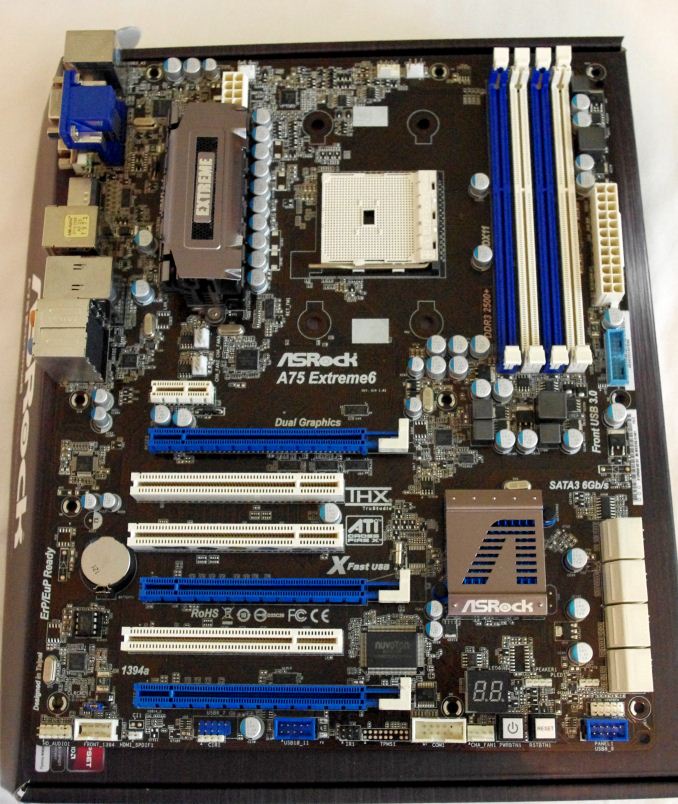
Llano throws a little oddball into the mix, being a true quad core unlike Trinity. The A75-UD4H from Gigabyte was the first one to hand, and offers two PCIe slots at x8/x8. Like the Core 2 Duo setup, we are not SLI enabled.
After finding an A8-3850 CPU as another comparison point for the A6-3650, I pulled out the A75 Extreme6, which offers three-way CFX as x8/x8 + x4 from the chipset as well as the configurations offered by the A75-UD4H.
For Trinity: The Gigabyte F2A85X-UP4
Technically A85X motherboards for Trinity support up to x8/x8 in Crossfire, but the F2A85X-UP4, like other high end A85X motherboards, implements four lanes from the chipset for 3-way AMD linking. Our initial showing on three-way via that chipset linking was not that great, and this review will help quantify this.
For AM3: The ASUS Crosshair V Formula
As the 990FX covers a lot of processor families, the safest place to sit would be on one of the top motherboards available. Technically the Formula-Z is newer and supports Vishera easier, but we have not had the Formula-Z in to test, and the basic Formula was still able to run an FX-8350 as long as we kept the VRMs cool as a cucumber. The CVF offers up to three-way CFX and SLI testing (x16/x8/x8).
The Memory
Our good friends at G.Skill are putting their best foot forward in supplying us with high end kits to test. The issue with the memory is more dependent on what the motherboard will support – in order to keep testing consistent, no overclocks were performed. This meant that boards and BIOSes limited to a certain DRAM multiplier were set at the maximum multiplier possible. In order to keep things fairer overall, the modules were adjusted for tighter timings. All of this is noted in our final setup lists.
Our main memory testing kit is our trusty G.Skill 4x4GB DDR3-2400 RipjawsX kit which has been part of our motherboard testing for over twelve months. For times when we had two systems being tested side by side, a G.Skill 4x4GB DDR3-2400 Trident X kit was also used.
For The Beast, which is one of the systems that has the issue with higher memory dividers, we pulled in a pair of tri-channel kits from X58 testing. These are high-end kits as well, currently discontinued as they tended to stop working with too much voltage. We have sets of 3x2GB OCZ Blade DDR3-2133 8-9-8 and 3x1GB Dominator GT DDR3-2000 7-8-7 for this purpose, which we ran at 1333 6-7-6 due to motherboard limitations at stock settings.
To end, our Core 2 Duo CPUs clearly gets their own DDR2 memory for completeness. This is a 2x2GB kit of OCZ DDR2-1033 5-6-6.


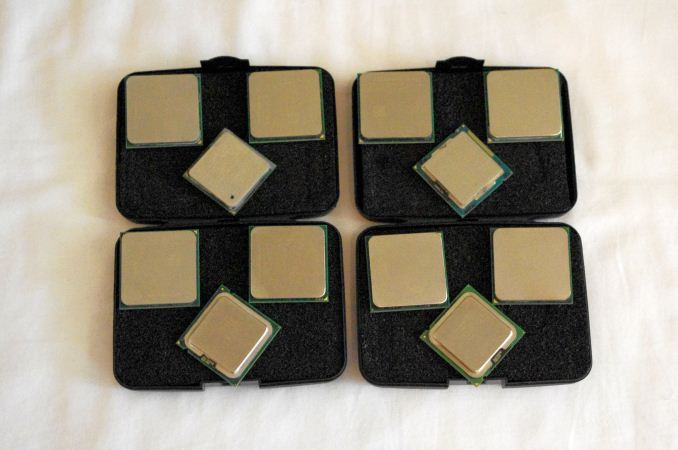
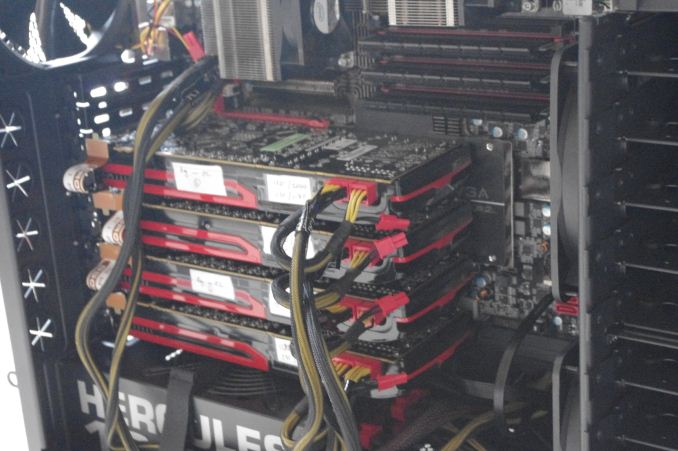
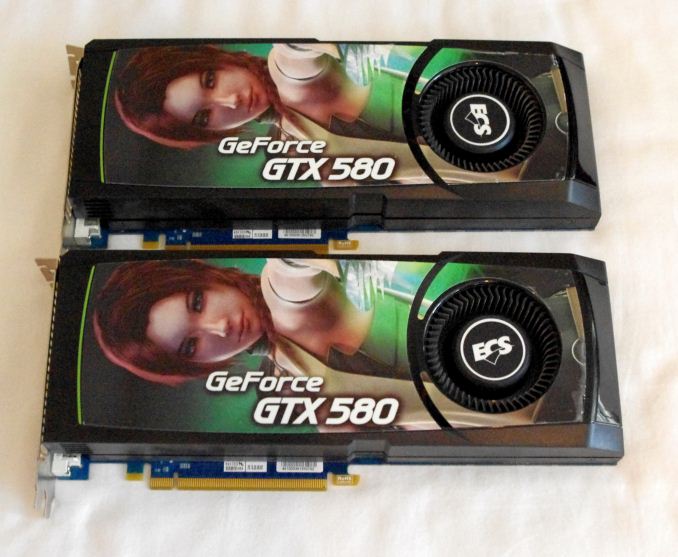
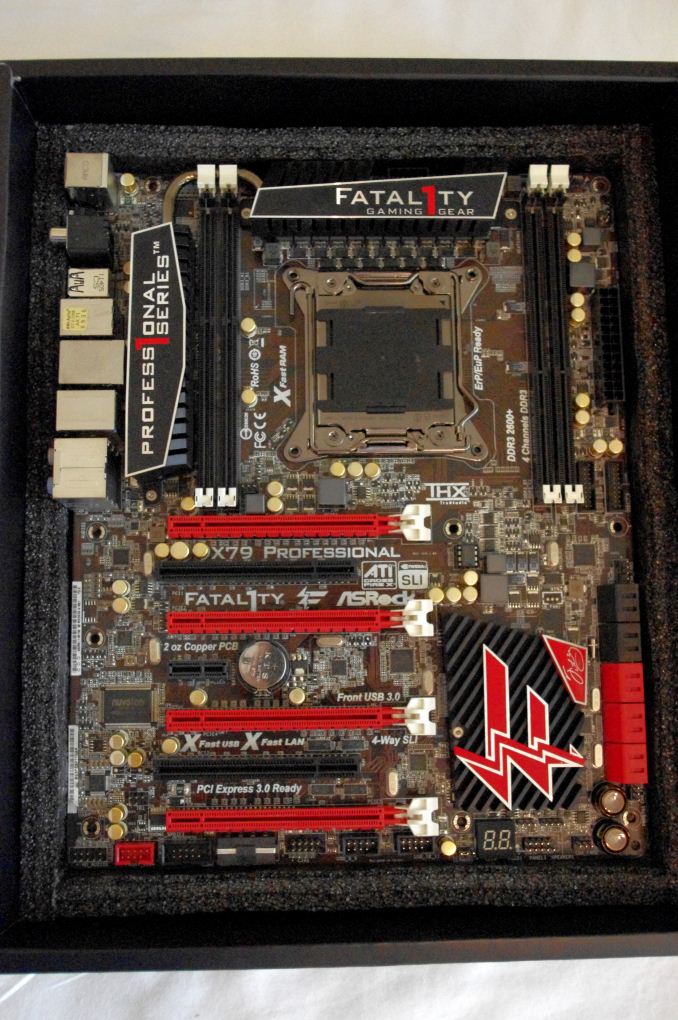
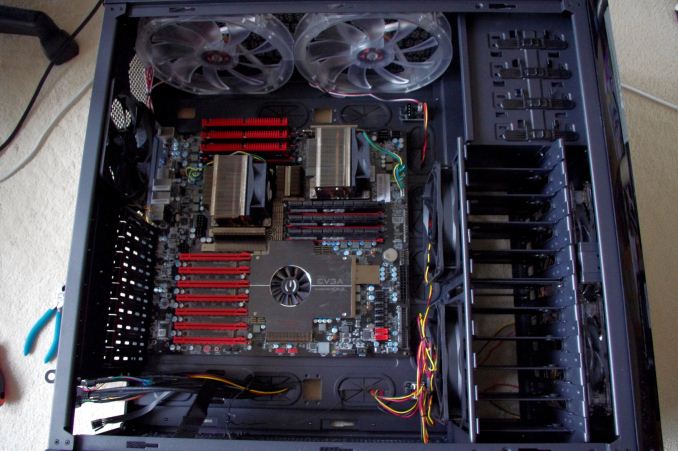
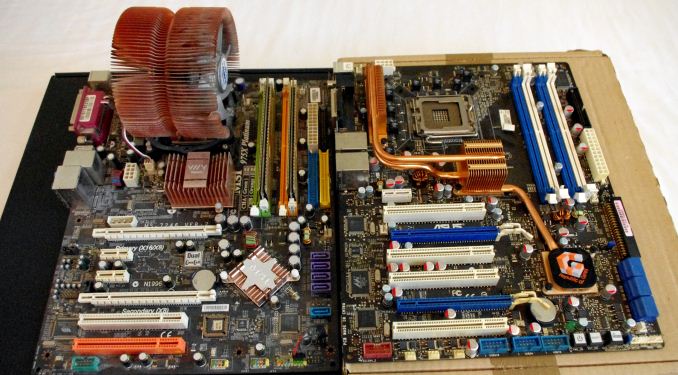
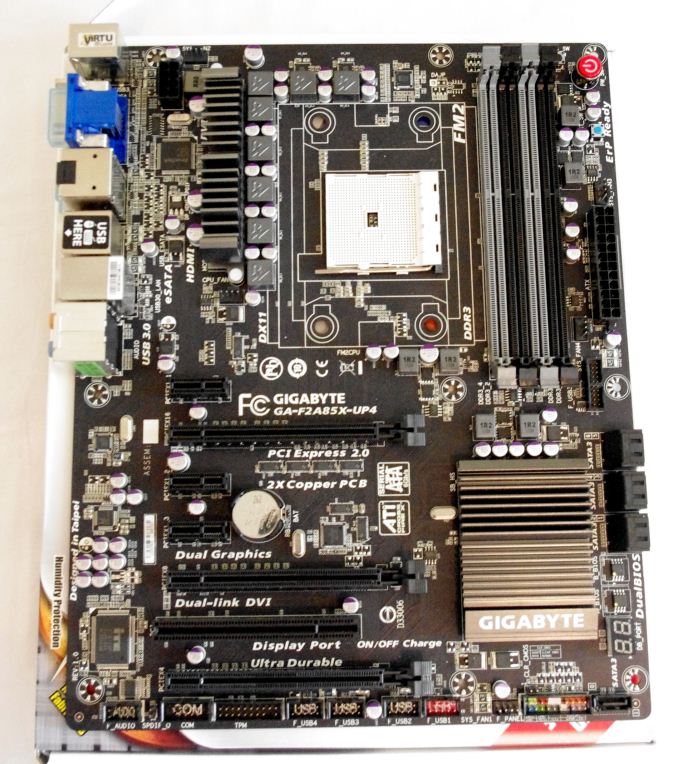
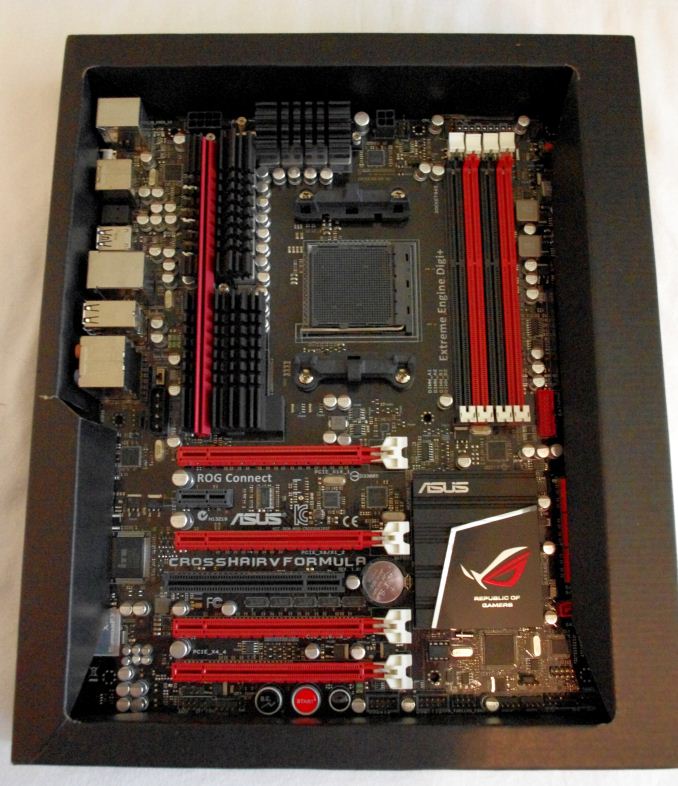

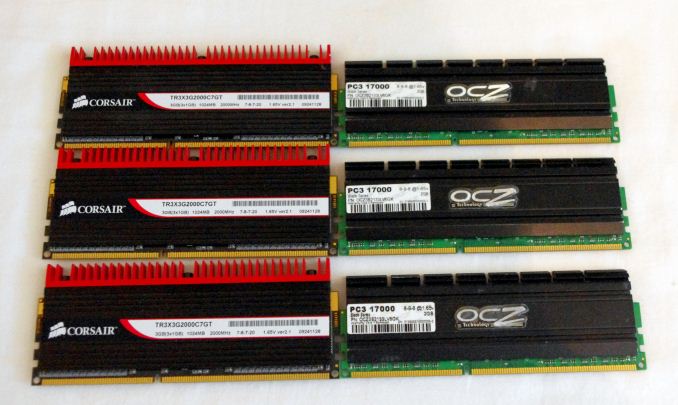
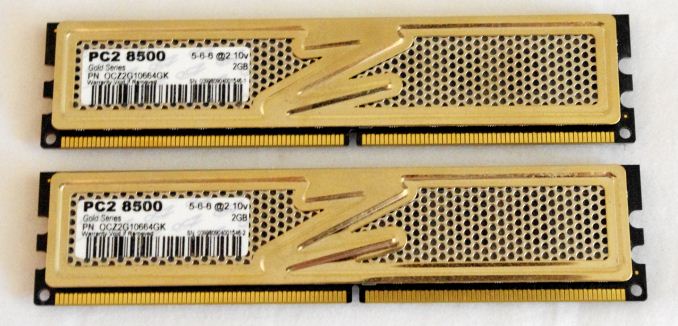








242 Comments
View All Comments
Spunjji - Wednesday, May 8, 2013 - link
Crap troll is crap.lorribot - Wednesday, May 8, 2013 - link
Would love to see something like a E3-1230 tested, it is around the same price as a i5-3570K but has no graphics, bigger cache and Hyper threading, but no over clocking and 100MHz lower clock. should be similar to a i7-3770 for around 60% of the price.Spunjji - Wednesday, May 8, 2013 - link
So let me get this straight. The engineers are idiots, yet you want them to go and work for other companies, the best candidate there being Intel. Also, thanks to this apparent mental handicap, they use Intel processors... oh, I get it, you're pro AMD!bikerbass77 - Wednesday, May 8, 2013 - link
Just a note as I keep seeing posts going on about Planetside 2 being CPU limited. It is not. I am saying this from experience having played it just fine on a Core2Duo based system. The reason you are most likely having problems will either be your ping or your GPU. I was running with a GTX 460 1gb card and it was fine for that particular game. I have just upgraded to a new CPU because the main game I play (Mechwarrior Online) is far more CPU bound being based on CryEngine 3.cusideabelincoln - Wednesday, May 8, 2013 - link
I think it should be noted that online multiplayer games are a different beast. Multiplayer is typically more CPU intensive, and if you're looking to maintain completely smooth gameplay without any dips in framerate or stuttering then the CPU becomes more important than it is for single player gaming.Also would you consider benchmarking live, online streaming of games? Would be great to see how much of a benefit the 3930K would have over other chips, and if Piledriver can pull ahead of the i5s definitively.
Markus_Antonius - Wednesday, May 8, 2013 - link
Your sample size is statistically beyond irrelevant which prevents the scientist in me from drawing any conclusions from it. In addition, claiming any sort of causal relationship between results is outright scientifically wrong even if the sample size would be statistically relevant. From an engineering standpoint the X79 systems with ample headroom in every relevant department would be the best choice to avoid any possible bottlenecks / contention issues in the largest possible number of different workloads.Any recent system with a recent CPU and recent midrange graphics card can play a game and can often play it well. Advising a Core i7 3770K based on a statistically irrelevant benchmark while disregarding systems architecture is something that neither the scientist, the software engineer and the hobbyist in me can get behind in any way.
JarredWalton - Wednesday, May 8, 2013 - link
Hyperbole, you have a new friend: meet Markus! "Beyond irrelevant", "any conclusions", "outright scientifically wrong", "ample headroom", "every relevant department", "best choice"....Let me guess: you have an X79 system, and it works great for you, and thus anyone even suggesting that it might not be the best thing since sliced bread is something you can't even think about in any way. This article is focused on gaming, and if you want to do things besides gaming yes, you will need to consider other facets of the system build. At the same time, if all you're looking for is a good gaming setup, perhaps with two or three GPUs, I have trouble imagining anyone recommending something other than i7-3770K right now (unless the recommendation is to "wait for Haswell").
Let me give you a few things to consider that, while the scientist may not necessarily agree, the software engineer and hobbyist definitely would avoid SNB-E and workstations. 1) Overall power requirements (they still matter). 2) Quick Sync (may not be perfect quality, but dang it's fast). 3) Better performance in many games with two GPUs, no matter what paper specs and system architectures might say.
smuff3758 - Thursday, May 9, 2013 - link
And that, Jared, is how to shut down this arrogant, condescending self-titled expert/scientist. I guess he must think the rest of us are bozos who come here for the comic relief?Markus_Antonius - Sunday, May 12, 2013 - link
My comment was about the testing method not being scientifically sound even though the author makes it a point to refer to the "well-adjusted scientist" in himself. There's a huge number of games out there as well as a lot of different mid-range to high-end video cards. Recommending an i7 3770K on the basis of one resolution tested and only 4 games is something that you absolutely cannot call science.I am among other responsibilities a software engineer and I don't actively avoid Sandy Bridge E and workstations.
My criticism of the methods used and the conclusions drawn is valid criticism, especially in the face of the article being given the appearance of being science.
If you're going to do recommendations based on statistics and for whatever reason decide to disregard engineering and the science behind systems design you're going to need a far larger sample size than what was used here.
You can deflect this all you want by quoting power usage and quicksync but while power usage power usage should be a factor, this test was not about quicksync. If it had been they would not have tested X79 systems at all ;-)
From both work and hobby I know a lot of power users and gaming remains one of the most demanding uses and one of the *most prevalent* demanding uses of a modern PC. Throwing a more powerful system aside and disregarding engineering needs to be done with a lot more care and thoroughness, all of which is missing here.
Answering valid criticism with scorn and aggression is also very telling. Perhaps you're more insecure than you thought you were?
Badelhas - Wednesday, May 8, 2013 - link
Great review, congrats!This comes at a perfect time for me, I just ordered a Qnix QX2710 1440p 27 inch monitor from ebay and a couple of 670´s to work along with my 2500k OCed to 4.5Ghz. It seems I will be amazed with that upgrade, lets see!
Cheers